
 When are we finally going to be able to copy poses?
When are we finally going to be able to copy poses?
It's a painstaking experience to select all the bones, then carefully selecting the keyframes which are linked to the bones, so we lose the whole bone selection. So I actually write down the bones I need so I don't lose track which is ridiculous... I then scroll through the HUGE list of keys and all of the bone names... And select bones through selecting keys... And then after all that, i carefully right-click and copy the keys hoping I dont mess up... And head over to another clip and arduously select the same bones all over again... and then when I hit ctrl+v, nothing happens, the keys get added but the pose does not change...
Please help

Hey,
thank you very much for your support request.
This is how I usually copy a pose:
- Click on the master key of the frame you want to copy the pose (this is the key at the very top). This selects all keys at this frame. It also selects all the bones that relate to those keys.
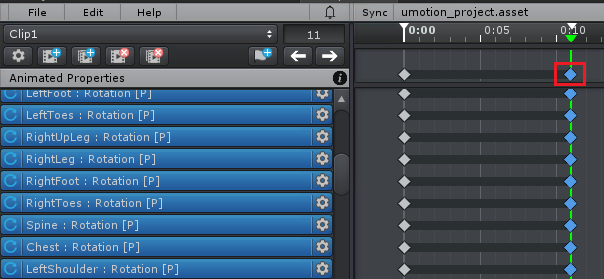
Special case: If you are missing some keys on this specific frame, you would immediately see this by some bones not being selected. You would need to create keys for those bones, otherwise those bones pose will be ignored in the copy process. If you don't want to add keys to an existing animation, you could create a duplicated version of that clip just for the purpose of grabbing animation poses from it:
- [Optionally] Deselect bones you don't want to copy (if you e.g. only want to copy an upper body pose, deselect all the leg bones). You can do this by holding [STRG] and clicking on a selected bone in the scene view OR by holding [STRG] and clicking on a selected animated property in the animated properties list.
- Once you have your selection, press CTR+C to copy the keys.
- Switch to your target animation.
- Move the frame cursor at the desired position.
- Press CTRL + V to past the keys.
This method requires that you selection synchronization enabled (which it is by default):
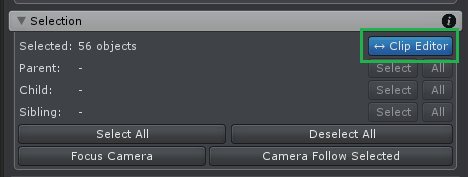
Pro Tip: If you re-use a lot of poses, create a "pose libary". An animation clip in your project that contains all the poses one after the other. Make sure that each pose is well-defined (i.e. it contains keys for every bone).
Please let me know in case you have any follow-up questions.
Best regards,
Peter

 How do we copy both the world position and rotation of an IK handle?
How do we copy both the world position and rotation of an IK handle?
It's possible to do one, but how do you do both?
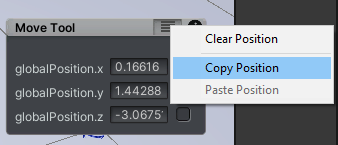
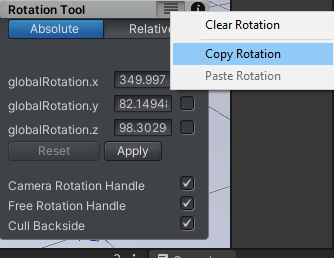

Hey,
thank you very much for reaching out.
Unfortunately there is currently no way to copy/paste the position and rotation at the same time. I've added this to my to-do list.
Please let me know in case you have any follow-up questions.
Best regards,
Peter

 Pass animation end point (center of mass) to other animation
Pass animation end point (center of mass) to other animation
Hello, I have two animations, "Idle" and "Get out of bed"
First animation "Idle"
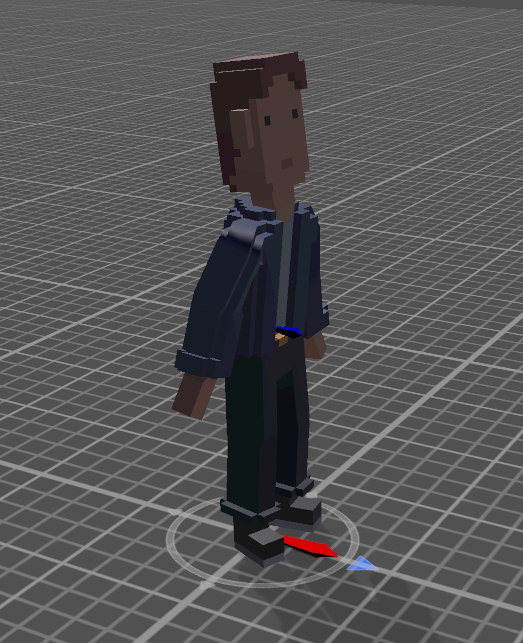
Second animation "Get out of bed"
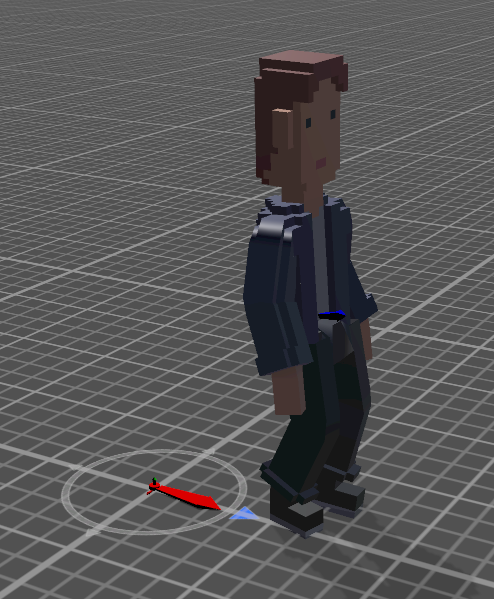
As you see the red center point on second animation is far from the character's feet and after I change second animation to first "Idle", character will return to red point center of first animation, how I can pass to "Idle" animation position of characters feet from "Get out of bed"?

Hi,
thank you very much for your support request.
Your animation is an "In-Place" animation. Meaning that when it moves, it does not move the red center point with it. In your case what you would like to use instead is a so called "Root-Motion" animation. That type of animation does move the center point.
Is your character of type "humanoid"? In that case, select the *.anim file and make sure that the "Bake Into Pose" setting of the "Root Transform Position (XZ)" is disabled. That should make the center move with the character.
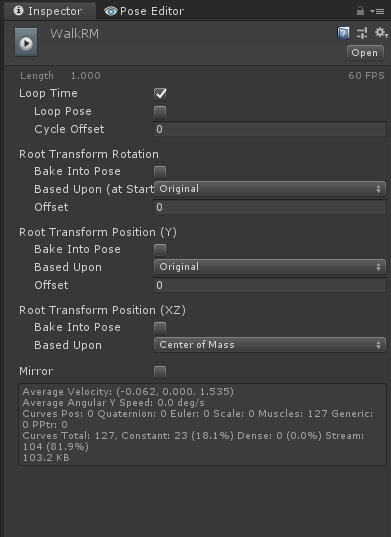
Also make sure to have "Root Motion" enabled in the Animator Component of your character in-game (in your actual scene) for this to work.
Here is Unity's documentation of the root motion settings: https://docs.unity3d.com/Manual/class-AnimationClip.html#ClipProperties
Please let me know in case you have any follow-up questions.
Best regards,
Peter

 Motion changes after edit ik
Motion changes after edit ik
I put FK to IK conversion an it works well. but after i change some motion with IK, some next motion or past motion changes weird automatically. it drives me crazy everytime :(
I changed this motion with IK. i fixed my legs and moved body up.
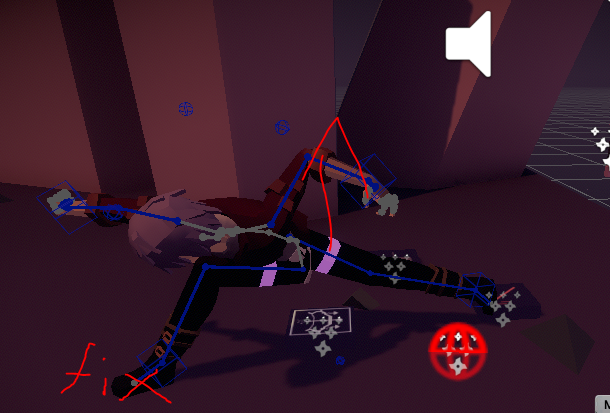
like this. and after modify...........
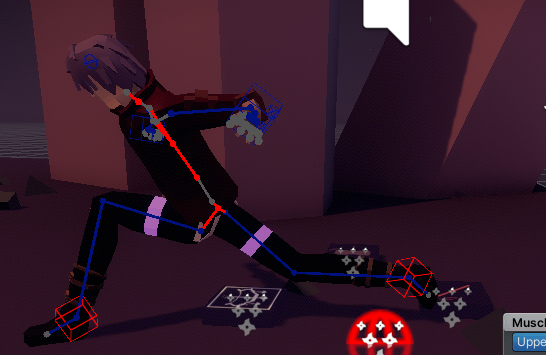
Next animation is changed suddenly like this. it happens always when i edit motion..
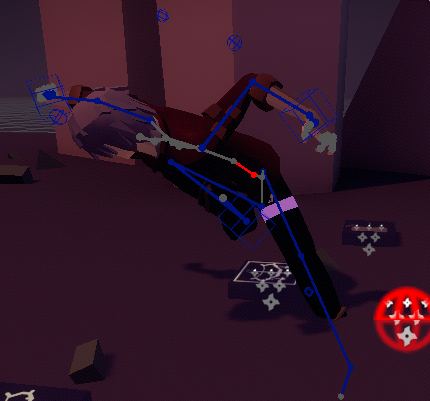
So i just want to edit motion without ik.
i want to pin these foots and move body up. is there way to only move body? because all bones follow body when i move hip(spine).
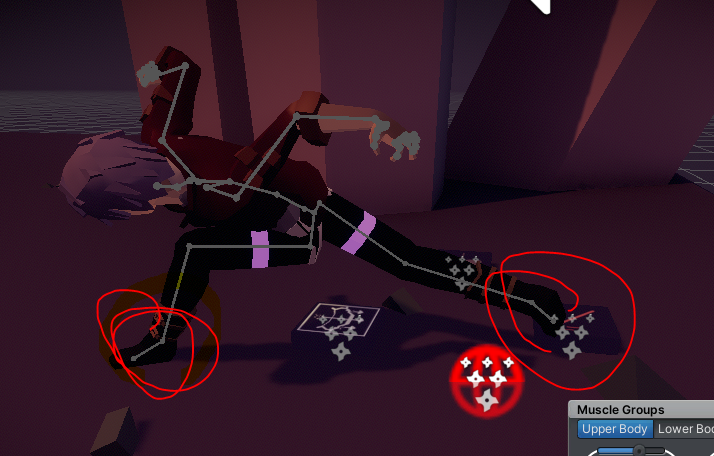

Hi,
thank you very much for your support request.
So i just want to edit motion without ik.
i want to pin these foots and move body up. is there way to only move body? because all bones follow body when i move hip(spine).
What you described is exactly the purpose of IK :-) You need IK in order to do that.
Next animation is changed suddenly like this
Just for clarification, with "next animation" you mean one of the following frames/poses within the same animation clip, right?
From the screenshots, I can only make some guesses:
You need to be careful when changing the IK pinning state during the animation. This can affect the following (already existing) keys of your IK target. When IK pinning is enabled, all following position/rotation keys of your IK handle are treated as "world space". While when IK pinning is disabled, the following position/rotation keys of your IK handle are treated as "local space". When you change the pinning state, UMotion automatically asks you (with a dialog) if it should convert the following keys.
When you don't correctly update your keys position/rotation values to match the IK pinning state (e.g. pinning is on but keys are in local space) you get wrong poses.
This is also explained in the child-of video tutorial (IK pinning is just a special mode of the child-of constraint):
Here is also the IK pinning video tutorial for completeness:
It's a bit hard for me to tell you exactly what happens just from static screenshots. If you need any further help, please record a video that first shows the complete working animation, then edit one frame/pose and then show me how that affected the pose on other frames. Then I can tell you exactly why this and that happened :-)
Best regards,
Peter
 Playing audio in Clip Editor
Playing audio in Clip Editor
I am creating an animation, and I need to sync it to an audio clip. How can I play an audio clip in the clip editor if that's possible?

Hi,
thank you very much for your support request.
Yes you can do that by using Unity Timeline and sync UMotion with Unity Timeline. I tested the following in Unity 2020.3. Audio scrubbing might not be available in old Unity versions. Here's how to do that:
- Create an empty GameObject in your scene and add an audio source component to it.
- Open Unity Timeline (Window --> Sequencing --> Timeline).
- Make sure your empty GameObject is selected and then click on the create button in Unity Timeline to create a new sequence.
- Click on the "plus" button and select "Audio Track".
- Right click on the empty track and select "Add From Audio Clip". Then select the audio clip you want to add.
- Make sure that audio scrubbing is enabled by going into "Edit --> Preferences":
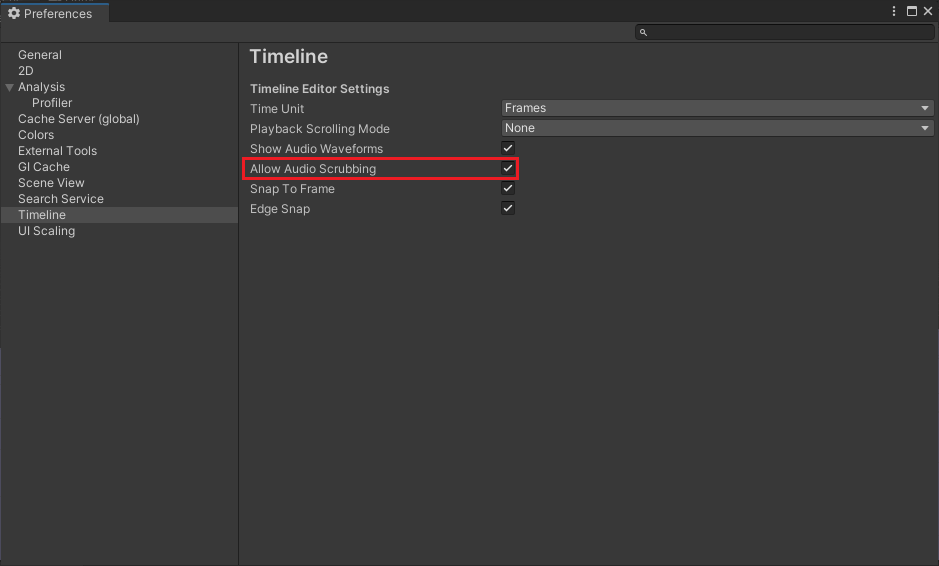
- Make sure that your character is assigned to the UMotion pose editor.
- Place the timeline window and the clip editor window next to each other. In case timeline isn't displaying your sequence, select your empty GameObject again in the scene view.
- Then click on "Sync --> Timeline Window --> No Offset" in the UMotion clip editor. Now the frame cursor of UMotion's clip editor and Unity Timeline move in sync thus also the audio is previewed in sync.
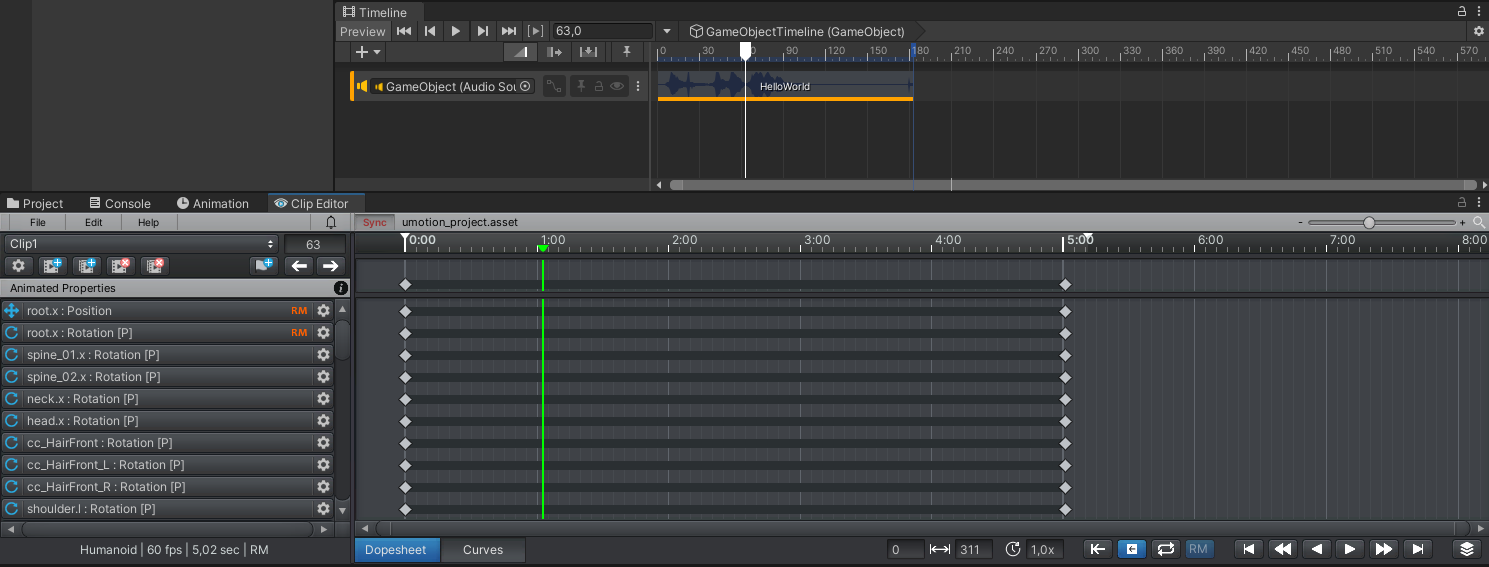
PS: In case audio preview isn't working, make sure that "Mute Audio" is disabled in the game view:
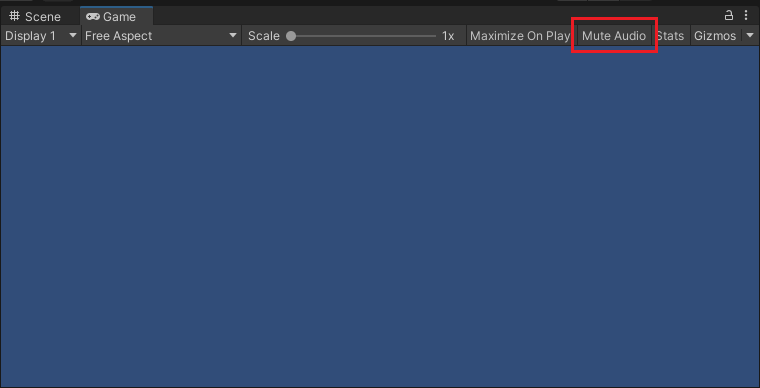
Please let me know in case you have any follow-up questions.
Best regards,
Peter

 Symmetric question..
Symmetric question..
Is there way change body symmetric?
like when i change chest to right at 0:00, i want to change it same degree 0:30 to the other side.

Hi Noah,
thanks for your support request.
Unfortunately there is no such feature in UMotion but I've took a note at my "ideas for the future" list.
Please let me know in case you have any follow-up questions.
Best regards,
Peter

 curve mode drag doesn't work
curve mode drag doesn't work

;list=PLI-5k9R34MAzGs-FomlWDZQXF93w6qyfD&index=5
0:15 seconds. i can edit by right click. but i can't drag it. it doesn't move.
How can i move it?
Thank you

Hi Noah,
thank you very much for your support request.
To drag a key, click with the left mouse button onto the key (and keep the left mouse button pressed), then move the mouse. The key should follow your mouse movement.
Please note that for rotational animation properties that use either "Progressive Quaternion Interpolation" (default) or "Quaternion Interpolation" as rotation mode, you can only drag the keys along the time axis (not up and down). Here is a dedicated video tutorial about the different rotation modes:
If you aren't even able to move the keys left/right along the time axis, please try to restart Unity and see if it works then. If that's also not working, try to create an empty Unity project, install UMotion and see if it works here. If it's also not working, then please let me know which UMotion version (click on "Help --> About UMotion" in the clip editor) and Unity version (see title bar of the Unity window) you are using. Please also include a screenshot that shows the whole clip editor window and the curves of which you are trying to move the keys.
Best regards,
Peter

 add animator.root node to an exixting clip
add animator.root node to an exixting clip
I have Umotion Pro and would like to use it to animate a clip with a Unity Native GameObject (say a simple Capsule with a small cube inside it) as generic adding animator.root properties bound to the cube (bone) to the clip.
In general this has to do with animating generic models not coming from outside but done inside unity being only GameObjects, and adding animator.root properties to them in new Umotion made clips.
Same of course with external models without root motion. Add to new Umotion made clips animator.root properties.
thanks
sergio from italy

Hi Sergio,
thank you very much for your support request.
- In UMotion, right click on a Position (and optional Rotation) animation property in the clip editor and from the context menu select "Root Motion". This marks the animated property as "should be driving root motion".
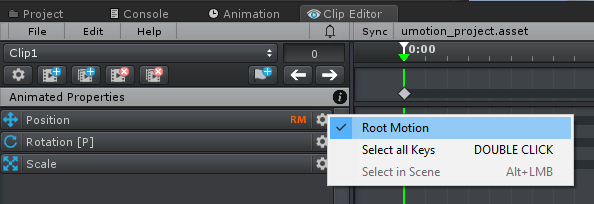
- Create your animation
- (Optional) If your clip should be looped, click on the button with the gear icon in the clip editor to open the clip settings. Set the tick mark at "Loop Clip":
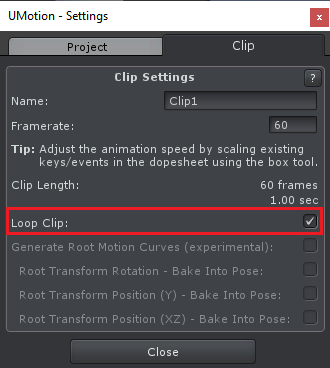
- Export your animation.
- Select the exported animation and in the inspector, adjust the root motion settings to your needs.
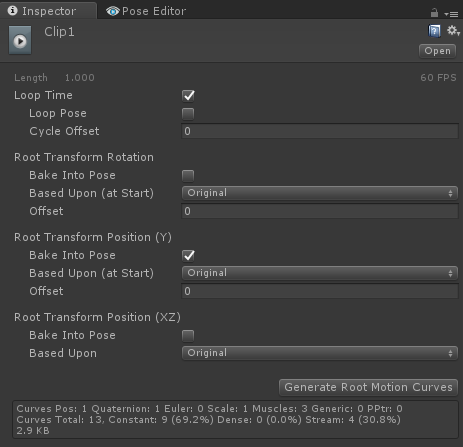
- Click on "Generate Root Motion Curves"
There is also a dedicated tutorial on root motion that might provide some additional information:
Please let me know in case you have any follow-up questions.
Best regards,
Peter
 Trick to modify posture
Trick to modify posture
Hi. I have an "idle crouch" animation and the camera in my game gives me the right position when crouching.
I also have a "crouch walk forward" animation but the posture is a bit higher than the idle one, so the camera goes up.
I don't want to modify the height of the camera of course. I need to modify the posture of the "crouch walk forward" animation to have the same height as the "idle crouch" animation.
I tried to copy and paste the hips position in all of the frames but then the feet goes under the ground. But I can't really just modify the position of the feet to touch the ground because in some frames the need to be in the air, however I don't know in which frames they need to go in the air because when I change the hips position it goes under the ground.
Is there an easier trick to modify the posture for the purpose I want? I'm using uMotion pro 1.26. Unity 2020.3.5.
Regards

Hi,
thank you very much for your support request.
With the help of IK Pinning you can keep the feet at their current floor position while adjusting the hips height:
- First convert the animation from FK to IK by clicking on "Edit --> Convert FK to IK". Start by only converting the legs to IK to not sacrifice the arm animation quality.
- Move the frame cursor to the first frame.
- Select the IK handles of the feet and make sure that "IK Pinned" is checked and that the "FK/IK Blend" channel is set to 1 (= IK).
- If you now modify the hips, the feet stay in place.
- You can use an additive animation layer to offset the hips across the whole animation.
A lot of this stuff is covered in this video tutorial:
Here is the dedicated IK Pinning tutorial:
Please also note that the root motion settings of the exported animation clip have great impact on how your animation is offset:
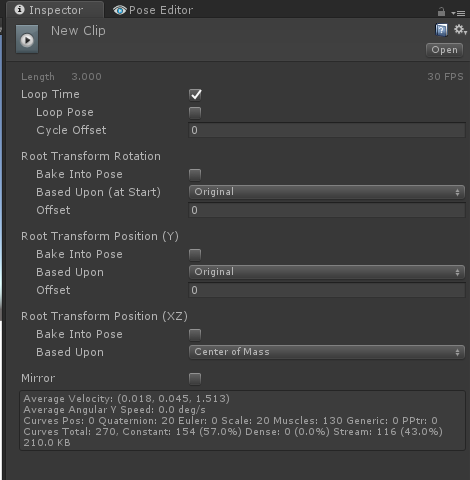
It might make sense that you enable the "Bake Into Pose" setting of the "Root Transform Position (Y)". Btw. you can also use the offset field here to offset your animation (but this also moves the feet).
Best regards,
Peter

 Unity animator overriding blendshapes
Unity animator overriding blendshapes
On my character I have Blendshapes for character creation such as Big_Nose, Little_Nose and also blenshapes for Realtime Animating like Smile, Frown etc.
In my character creation code I set the blendshapes (SetBlendShapeWeight) for the character Big_Nose etc.
The problem is the Animator overrides the Big_Nose setting it back to zero
How can I prevent this from happening?

*** SOLVED ***
it's 4am fortunately I noticed one of the character creation blendshapes wasn't getting reset by the animator, long story short that blendshape didn't have a key at the start in Umotion. So I simply made sure that all the character creation blendshapes have no keys at all.
Thanks Peter for providing the facility for me to ask my question, Umotion is by far the most Professional Asset I own and I own alot. if you search for the top rated assets I have just about the first 3 pages and many more.
Cheers
Roy
Customer support service by UserEcho
